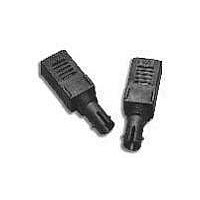HFBR-2116TZ Avago Technologies US Inc., HFBR-2116TZ Datasheet - Page 4

HFBR-2116TZ
Manufacturer Part Number
HFBR-2116TZ
Description
Fiber Optic Receiver,Module-ST
Manufacturer
Avago Technologies US Inc.
Datasheet
1.HFBR-2116TZ.pdf
(12 pages)
Specifications of HFBR-2116TZ
Data Rate
155MBd
Voltage - Supply
4.5 V ~ 5.5 V
Power - Minimum Receivable
-31dBm
Current - Supply
82mA
Applications
General Purpose
Product
Receiver
Wavelength
1300 nm
Maximum Rise Time
2.2 ns
Maximum Fall Time
2.2 ns
Pulse Width Distortion
1 ns
Maximum Output Current
50 mA
Operating Supply Voltage
4.5 V to 5.5 V
Maximum Operating Temperature
+ 70 C
Minimum Operating Temperature
0 C
Package / Case
DIP-16 with Connector
Function
Designed for for 50 or 62.5 um core multimode optical fiber, for ATM UNI applications.
Lead Free Status / RoHS Status
Lead free / RoHS Compliant
For Use With
Multimode Glass
Lead Free Status / RoHS Status
Lead free / RoHS Compliant
Available stocks
Company
Part Number
Manufacturer
Quantity
Price
Company:
Part Number:
HFBR-2116TZ
Manufacturer:
Avago Technologies
Quantity:
135
CONDITIONS:
1. PRBS 2
2. DATA SAMPLED AT CENTER OF DATA SYMBOL.
3. BER = 10
4. T
5. V
6. INPUT OPTICAL RISE/FALL TIMES = 1.0/2.1 ns.
Figure 5. Transmitter/Receiver relative
optical power budget at constant BER vs.
signaling rate.
Transmitter and Receiver Signaling
Rate Range and BER Performance
For purposes of definition, the
symbol rate (Baud), also called
signaling rate, is the reciprocal of
the symbol time. Data rate (bits/
sec) is the symbol rate divided by
the encoding factor used to encode
the data (symbols/bit).
When used in 115 Mbps SONET
OC-3 applications, the perform-
ance of Avago Technologies’
1300 nm data link modules, HFBR-
1116TZ/-2116TZ, is guaranteed to
the full conditions listed in the
individual product specification
tables.
The data link modules may be used
for other applications at signaling
rates different than the 155 Mbps
with some variation in the link
optical power budget. Figure 5
gives an indication of the typical
performance of these 1300 nm
products at different rates.
4
A
CC
2.5
2.0
1.5
1.0
0.5
0.5
= 25° C
0
= 5 Vdc
0
7
-1
-6
25
50
SIGNAL RATE (MBd)
75 100 125
150
175
200
1 x 10
1 x 10
1 x 10
1 x 10
1 x 10
1 x 10
1 x 10
1 x 10
1 x 10
1 x 10
1 x 10
These data link modules can also
be used for applications which
require different bit-error-ratio
(BER) performance. Figure 6
illustrates the typical trade-off
between link BER and the receiver
input optical power level.
Figure 6. Bit error ratio vs. relative receiver
input optical power.
Data Link Jitter Performance
The Avago 1300 nm data link
modules are designed to operate
per the system jitter allocations
stated in Table B1 of Annex B of
the ANSI T1E1.2 Revision 3
standard.
The 1300 nm transmitter will
tolerate the worst-case input
electrical jitter allowed in Annex B
without violating the worst-case
output jitter requirements.
The 1300 nm receiver will tolerate
the worst-case input optical jitter
allowed in Annex B without
violating the worst-case output
electrical jitter allowed.
CONDITIONS:
1. 155 MBd
2. PRBS 2
3. T
4. V
5. INPUT OPTICAL RISE/FALL TIMES = 1.0/2.1 ns.
-10
-11
-12
-2
-3
-4
-5
-6
-7
-8
-9
RELATIVE INPUT OPTICAL POWER – dB
A
CC
-6
= 25° C
= 5 Vdc
7
-1
-4
CENTER OF SYMBOL
-2
0
2
4
The jitter specifications stated in
the following transmitter and
receiver specification table are
derived from the values in Table
B1 of Annex B. They represent the
worst-case jitter contribution that
the transmitter and receiver are
allowed to make to the overall
system jitter without violating the
Annex B allocation example. In
practice, the typical jitter
contribution of the Avago data link
modules is well below the
maximum allowed amounts.
Recommended Handling Precautions
It is advised that normal static pre-
cautions be taken in the handling
and assembly of these data link
modules to prevent damage which
may be induced by electrostatic
discharge (ESD). The HFBR-
1116TZ/-2116TZ series meets MIL-
STD-883C Method 3015.4 Class 2.
Care should be taken to avoid
shorting the receiver Data or
Signal Detect Outputs directly to
ground without proper current-
limiting impedance.
Solder and Wash Process
Compatibility
The transmitter and receiver are
delivered with protective process
caps covering the individual ST*
ports. These process caps protect
the optical subassemblies during
wave solder and aqueous wash
processing and act as dust covers
during shipping.
These data link modules are
compatible with either industry
standard wave- or hand-solder
processes.

























